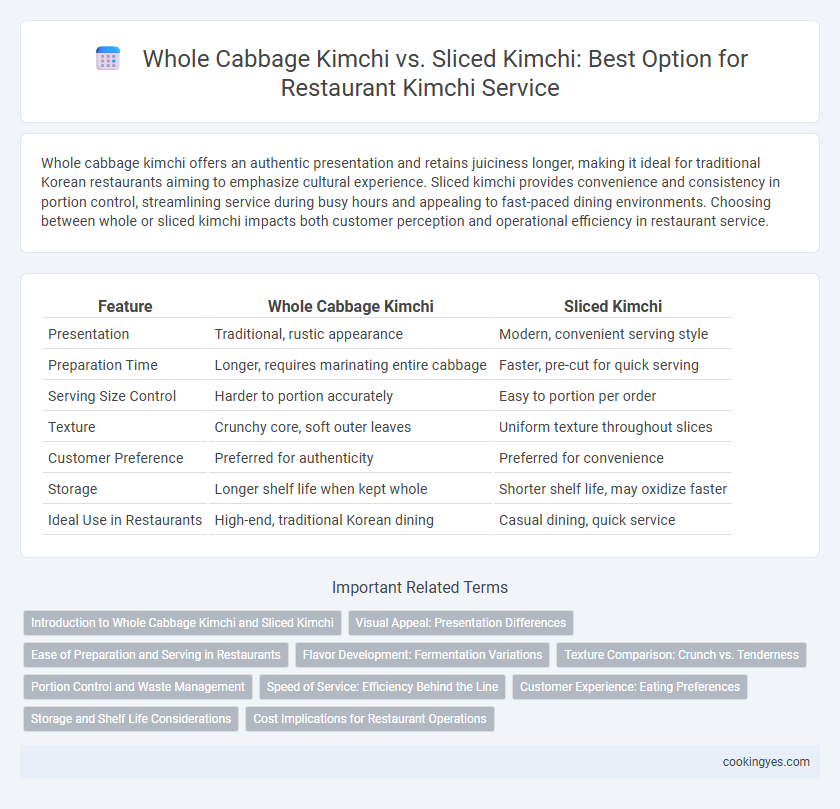Whole cabbage kimchi offers an authentic presentation and retains juiciness longer, making it ideal for traditional Korean restaurants aiming to emphasize cultural experience. Sliced kimchi provides convenience and consistency in portion control, streamlining service during busy hours and appealing to fast-paced dining environments. Choosing between whole or sliced kimchi impacts both customer perception and operational efficiency in restaurant service.
Table of Comparison
| Feature | Whole Cabbage Kimchi | Sliced Kimchi |
|---|---|---|
| Presentation | Traditional, rustic appearance | Modern, convenient serving style |
| Preparation Time | Longer, requires marinating entire cabbage | Faster, pre-cut for quick serving |
| Serving Size Control | Harder to portion accurately | Easy to portion per order |
| Texture | Crunchy core, soft outer leaves | Uniform texture throughout slices |
| Customer Preference | Preferred for authenticity | Preferred for convenience |
| Storage | Longer shelf life when kept whole | Shorter shelf life, may oxidize faster |
| Ideal Use in Restaurants | High-end, traditional Korean dining | Casual dining, quick service |
Introduction to Whole Cabbage Kimchi and Sliced Kimchi
Whole cabbage kimchi offers visually appealing presentation and traditional flavor, making it ideal for upscale restaurant service that prioritizes authenticity and customer experience. Sliced kimchi provides convenience and faster fermentation, suitable for high-volume kitchens seeking consistent portion control and quicker turnaround. Choosing between whole and sliced kimchi depends on the balance between aesthetic impact, preparation time, and operational efficiency in the restaurant setting.
Visual Appeal: Presentation Differences
Whole cabbage kimchi offers a dramatic visual centerpiece with its layered structure and rich, vibrant colors, ideal for creating a traditional and authentic ambiance in restaurants. Sliced kimchi presents a more uniform and manageable appearance, enhancing practical plating and allowing for easy portion control while maintaining an appetizing look. The choice between whole cabbage and sliced kimchi significantly impacts presentation style, influencing diners' perception of freshness and culinary craftsmanship.
Ease of Preparation and Serving in Restaurants
Whole cabbage kimchi requires more preparation time due to the need for careful fermentation and handling, while sliced kimchi offers convenience with pre-cut pieces that streamline plating and portion control. Sliced kimchi reduces labor costs and accelerates service speed, making it ideal for high-volume restaurant environments. The uniformity of sliced kimchi also enhances presentation consistency, contributing to an efficient and aesthetically pleasing dining experience.
Flavor Development: Fermentation Variations
Whole cabbage kimchi undergoes a slower, more complex fermentation process, allowing deeper flavor development with rich umami notes and balanced acidity. Sliced kimchi ferments more rapidly due to increased surface area exposure, resulting in a tangier, sharper taste ideal for quick service. Restaurants seeking nuanced, traditional flavors prefer whole cabbage kimchi, while those prioritizing speedy preparation lean towards sliced kimchi for consistent, vibrant taste.
Texture Comparison: Crunch vs. Tenderness
Whole cabbage kimchi offers a firmer texture with a satisfying crunch that enhances the eating experience, ideal for dishes requiring distinct bite and structure. Sliced kimchi delivers a tender, softer consistency, blending seamlessly into soups and stews, providing a smooth texture without overpowering other ingredients. Restaurants can choose whole cabbage kimchi to highlight crispness and presentation or sliced kimchi for easy integration and tenderness in diverse menu offerings.
Portion Control and Waste Management
Whole cabbage kimchi offers portion control challenges due to its bulky size, often leading to inconsistent serving sizes and increased food waste in restaurant service. Sliced kimchi allows precise portioning, reducing over-serving and minimizing waste by facilitating easier inventory management and faster consumption. Efficient waste management is achieved with sliced kimchi through standardized portions that help maintain cost control and promote sustainability in food service operations.
Speed of Service: Efficiency Behind the Line
Whole cabbage kimchi requires longer preparation and serving time due to its larger size and need for portioning, which can slow down service during peak hours. Sliced kimchi offers faster plating and easier handling, enhancing kitchen efficiency and reducing wait times for customers. Restaurants prioritizing speed of service often prefer sliced kimchi to maintain a smooth workflow behind the line.
Customer Experience: Eating Preferences
Whole cabbage kimchi provides an authentic and traditional eating experience that appeals to customers who appreciate texture and presentation, enhancing visual appeal on the plate. Sliced kimchi offers convenience and ease of consumption, making it a preferred choice for busy diners or casual settings where quick bites are expected. Both options influence customer satisfaction differently, with whole cabbage emphasizing artisanal value and sliced kimchi prioritizing practical dining efficiency.
Storage and Shelf Life Considerations
Whole cabbage kimchi retains freshness longer due to its intact leaves, which slow fermentation and reduce spoilage, making it ideal for bulk storage in restaurant settings. Sliced kimchi ferments faster because of increased surface area exposure, requiring quicker consumption and more frequent replenishment to maintain quality. Proper refrigeration at temperatures between 0-4degC can extend shelf life, but whole cabbage kimchi typically lasts up to four weeks, while sliced kimchi remains optimal for one to two weeks.
Cost Implications for Restaurant Operations
Whole cabbage kimchi demands higher initial preparation and storage costs due to its larger size and longer fermentation control, impacting inventory management and refrigeration space efficiency. Sliced kimchi offers cost benefits through faster portioning and reduced waste, enabling quicker service turnaround and consistent dish pricing. Restaurants balancing quality and operational expenses often favor sliced kimchi for improved cost control and streamlined kitchen workflow.
Whole Cabbage Kimchi vs Sliced Kimchi for restaurant service Infographic

 cookingyes.com
cookingyes.com